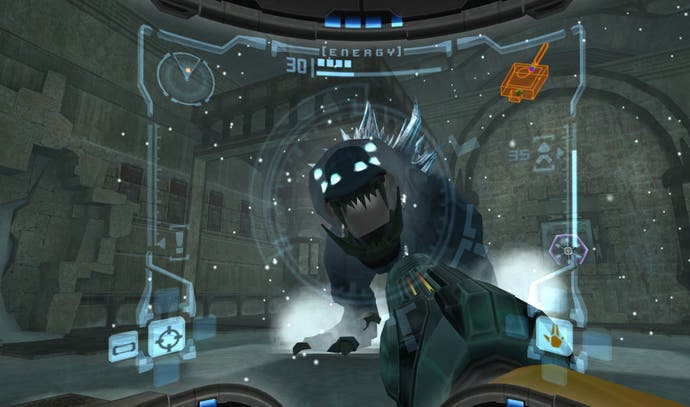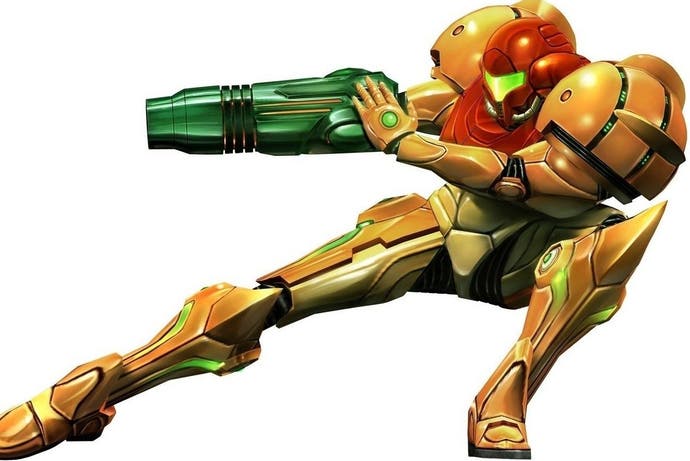Metroid Prime remains one of Nintendo's finest games
Why Retro Studios' masterpiece is as essential now as it was in 2002.
Metroid has always been a mesh of different DNA: a little of Zelda's exploration mixed in with the acrobatics of Mario and then tied together with some good old fashioned plasma ballistics. Even taking into account that heritage, there was nothing quite like Metroid Prime when it launched in 2002. Coming up to 13 years later, and despite a couple of high quality sequels and almost a decade of increasingly fevered begging from fans, there's been nothing like it ever since.
This is a unique game, and certainly a very special one. Returning to it today - which is now easier than ever thanks to the recent release of Metroid Prime Trilogy on the Wii U's Virtual Console - it's clear that the years haven't dulled its atmosphere or undermined its achievements. If anything, they're brought sharper into focus: as an updating of a 2D classic into three dimensions, the original Prime has earned itself a place alongside Super Mario 64 as one of Nintendo's greats. Alongside the excellent Super Metroid, it's also a high watermark for the space-faring series.
There's much shared between those two games, of course, but nothing's ever merely borrowed in Metroid Prime. Instead it's thoughtfully retooled, reshaped and placed in an all-new template that's every bit as intoxicating as that of the classics it succeeds.
What strikes you first is the silence. After the bombastic introduction, all blaring sirens and the steam-hiss and bang of a space station on meltdown, the expanses of the planet Tallon IV that plays host to the rest of the adventure are wind-whipped by an eerie, alien quiet. It's a silence softly complemented by Kenji Yamamoto's score, delivering gentle, pulsing sci-fi soundscapes with an otherworldliness sharpened by a heroic edge.
You couldn't find a more fitting soundtrack for heroine Samus Aran herself. Even when stripped of all of her abilities - in the series' time-honoured tradition - she's potent with power and purpose. She's silent too, though she's still a more expressive lead than so many other protagonists that have followed, armed with their reams of dialogue and a Blu-ray's worth of cutscenes. Other M's decision to fully voice Samus feels like even more of a mis-step when admiring the detail present in Prime.
You'll sense her strength as she rises from the gunship, shoulders flexed in a defiant pose, just as you'll sense the dimmest flicker of trepidation as she glances around in the fleeting third-person lift transition animation. Looking back through the macho miasma of the last decade of mainstream gaming you see something else in Samus too, her open-eyed stare that's reflected back on you seems like a perfect counterpoint to all the testosterone-drenched shooters that would follow.
As much as Samus is the star - with her poise as well as her ever-expanding arsenal, she's one of the finest Nintendo has created - it's of course Tallon IV itself that earns equal billing. It's an astonishing environment, a coherent collection of grand stonework hallways, metal mesh corridors and soft mossy footpaths that fold in on themselves long before Dark Souls' Lordran repeated the same trick.

There's character and art that help Prime go beyond mere video game or sci-fi pastiche. Phendrana Drifts and Magmoor Caverns manage to transform worlds of fire and ice, elements wearily trundled out in so many other games, into tangible places, where you can feel the sun-hot singe of lava pools, and where you can feel your lungs burn with the inhalation of bitter-sharp wintry air. The Chozo Ruins creak with history; touch one of its walls and you'd feel Prime's narrative of elegiac decay tickle your fingers as the dust sifted through.
So much that Prime gets right - the atmosphere, the character and the slowly unfurling labyrinth map - is thanks to the SNES predecessor that came some eight years beforehand, but it's what's added that makes it all so phenomenal. It's all the more remarkable for being the work of an external studio reportedly feeling the back-burn of the turn of the century dotcom insanity.
Retro Studios put serious thought into what the move to three dimensions would bring to Metroid, and doubled down on what makes the series so great. This is a game all about exploration, about the slow methodical study of the environment and piecing together the various tools to help you conquer it. It's a trait shared by many other games, of course, but so few of them have done so as expertly as Prime; this is a game, after all, where one of its key and most satisfying mechanics is the simple scanning of what's around you.
Metroid Prime's smart enough to reward players for the simple act of looking, of drinking in the strange yet tangible architecture the artists have conjured, by filling out entries in a self-contained encyclopaedia. There's firepower in Prime and no shortage of things to aim it towards - an aspect at its best in the heart-stopping boss battles that act as perfect punctuation for all the exploration, made less of a nuisance thanks to the sharper control that the repackaged Trilogy brings - but it pales next to the thrill of scratching up another entry into Samus' log book.

There were two other Primes, of course, and both of them shared many of the pleasures of the 2002 original, though they often feel like dilutions of what made the original so special. Echoes introduces the satisfaction of besting its notorious challenge, though in doing so it gets lost in itself, while by the time Corruption came around, the silence of Samus' adventures was beginning to be lost amidst the noise of new characters and a more explicitly delivered story. Other M, Team Ninja's own foray into the world of Metroid that was to benefit from the presence of Super Metroid's director Yoshio Sakamoto, added more voices and found itself even further away from the magic conjured by Retro Studios' first game.
In the years since, there's famously been silence of another kind surrounding the series, and somewhat depressingly so. This time last year I found myself depressed that, at a time when Princess Peach and Zelda were up for being rescued each and every new financial year, Samus seemed locked away in another castle forever.
There's reason for more optimism now, though - not only with the attention lavished on the series that the Trilogy's re-release brings, but also with recent comments that Nintendo is considering a future for the series in both two and three dimensions, raising hopes that we may see a dual release much like when Prime was accompanied by the excellent Game Boy Advance outing Metroid Fusion. We can but hope that Samus' return isn't far away. Considering what heights the series is capable of, we've been waiting far too long.


